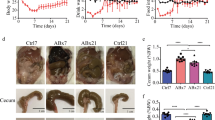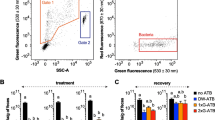Abstract
The gut microbiota is closely related to host health and disease. However, there are no suitable animal models available at present for exploring its functions. We analyzed the effect of 3 different antibiotic cocktails (ABx) via two administration routes on the composition of murine gut microbiota, as well as on the general physiological and metabolic indices. High-throughput 16S rRNA sequencing showed that ABx treatment altered the gut microbiota community structure, and also caused low-degree inflammation in the colon. In addition, ad libitum administration of antibiotics depleted the gut microbiota more effectively compared to direct oral gavage, especially with 3ABx. The ABx treatment also had a significant impact on renal and liver functions, as indicated by the altered serum levels of creatinine, urea, total triglycerides, and total cholesterol. Finally, Spearman’s correlation analysis showed that the predominant bacterial genera resulting from ABx intervention, including Lactobacillus, Roseburia, and Candidatus-Saccharimonas, were negatively correlated with renal function indices. Taken together, different antibiotic combinations and interventions deplete the gut microbiota and induce physiological changes in the host. Our findings provide the basis for developing an adaptive animal model for studying gut microbiota.
Key points
• Ad libitum administration of 3ABx can effectively deplete intestinal microbiota.
• ABx treatment may have slight effect on renal and liver function.
• The levels of urea and creatinine correlated with the growth of Roseburia.







Similar content being viewed by others
Data availability
Data from the study are available in NCBI-SRA under accession number PRJNA 661221.
References
Antharam VC, Li EC, Ishmael A, Sharma A, Mai V, Rand KH, Wang GP (2013) Intestinal dysbiosis and depletion of butyrogenic bacteria in Clostridium difficile infection and nosocomial diarrhea. J Clin Microbiol 51(9):2884–2892. https://doi.org/10.1128/jcm.00845-13
Bowman AP, Bogie JFJ, Hendriks JJA, Haidar M, Belov M, Heeren RMA, Ellis SR (2020) Evaluation of lipid coverage and high spatial resolution MALDI-imaging capabilities of oversampling combined with laser post-ionisation. Anal Bioanal Chem 412(10):2277–2289. https://doi.org/10.1007/s00216-019-02290-3
Candon S, Perez-Arroyo A, Marquet C, Valette F, Foray AP, Pelletier B, Milani C, Ventura M, Bach JF, Chatenoud L (2015) Antibiotics in early life alter the gut microbiome and increase disease incidence in a spontaneous mouse model of autoimmune insulin-dependent diabetes. PLoS One 10(5):e0125448. https://doi.org/10.1371/journal.pone.0125448
Degtyareva NN, Gong C, Story S, Levinson NS, Oyelere AK, Green KD, Garneau-Tsodikova S, Arya DP (2017) Antimicrobial activity, AME resistance, and a-site binding studies of anthraquinone-neomycin conjugates. ACS Infect Dis 3(3):206–215. https://doi.org/10.1021/acsinfecdis.6b00176
Desbonnet L, Clarke G, Traplin A, O'Sullivan O, Crispie F, Moloney RD, Cotter PD, Dinan TG, Cryan JF (2015) Gut microbiota depletion from early adolescence in mice: Implications for brain and behaviour. Brain Behav Immun 48:165–173. https://doi.org/10.1016/j.bbi.2015.04.004
Dingsdag SA, Hunter N (2018) Metronidazole: an update on metabolism, structure-cytotoxicity and resistance mechanisms. J Antimicrob Chemother 73(2):265–279. https://doi.org/10.1093/jac/dkx351
Dorożyńska I, Majewska-Szczepanik M, Marcińska K, Szczepanik M (2014) Partial depletion of natural gut flora by antibiotic aggravates collagen induced arthritis (CIA) in mice. Pharmacol Rep 66(2):250–255. https://doi.org/10.1016/j.pharep.2013.09.007
Ekmekciu I, von Klitzing E, Neumann C, Bacher P, Scheffold A, Bereswill S, Heimesaat MM (2017) Fecal microbiota transplantation, commensal Escherichia coli and Lactobacillus johnsonii strains differentially restore intestinal and systemic adaptive immune cell populations following broad-spectrum antibiotic treatment. Front Microbiol 8:2430. https://doi.org/10.3389/fmicb.2017.02430
Ferreira MA, Pereira ML, Dos Santos KV (2020) Drug-induced tolerance: the effects of antibiotic pre-exposure in Stenotrophomonas maltophilia. Future Microbiol 15:497–508. https://doi.org/10.2217/fmb-2019-0253
Goldstein EJC, Citron DM, Tyrrell KL (2018) In vitro activity of eravacycline and comparator antimicrobials against 143 recent strains of Bacteroides and Parabacteroides species. Anaerobe 52:122–124. https://doi.org/10.1016/j.anaerobe.2018.06.016
Holmes E, Li JV, Athanasiou T, Ashrafian H, Nicholson JK (2011) Understanding the role of gut microbiome-host metabolic signal disruption in health and disease. Trends Microbiol 19(7):349–359. https://doi.org/10.1016/j.tim.2011.05.006
Jena PK, Sheng L, Liu HX, Kalanetra KM, Mirsoian A, Murphy WJ, French SW, Krishnan VV, Mills DA, Wan YY (2017) Western diet-induced dysbiosis in farnesoid X receptor knockout mice causes persistent hepatic inflammation after antibiotic treatment. Am J Pathol 187(8):1800–1813. https://doi.org/10.1016/j.ajpath.2017.04.019
Jordan DC, Inniss WE (1959) Selective inhibition of ribonucleic acid synthesis in Staphylococcus aureus by vancomycin. Nature 184(Suppl 24):1894–1895. https://doi.org/10.1038/1841894b0
Jordan DC, Mallory HD (1964) Site of action of vancomycin on Staphylococcus aureus. Antimicrob Agents Chemother (Bethesda) 10:489–494
Kasubuchi M, Hasegawa S, Hiramatsu T, Ichimura A, Kimura I (2015) Dietary gut microbial metabolites, short-chain fatty acids, and host metabolic regulation. Nutrients 7(4):2839–2849. https://doi.org/10.3390/nu7042839
Khan I, Azhar EI, Abbas AT, Kumosani T, Barbour EK, Raoult D, Yasir M (2016) Metagenomic analysis of antibiotic-induced changes in gut microbiota in a pregnant rat model. Front Pharmacol 7:104. https://doi.org/10.3389/fphar.2016.00104
Ma J, Hong Y, Zheng N, Xie G, Lyu Y, Gu Y, Xi C, Chen L, Wu G, Li Y (2020) Gut microbiota remodeling reverses aging-associated inflammation and dysregulation of systemic bile acid homeostasis in mice sex-specifically. Gut Microbes 11(10):1–25
Maeda K, Osato T, Umezawa H (1953) A new antibiotic, azomycin. J Antibiot (Tokyo) 6(4):182
Marcus EA, Inatomi N, Nagami GT, Sachs G, Scott DR (2012) The effects of varying acidity on Helicobacter pylori growth and the bactericidal efficacy of ampicillin. Aliment Pharmacol Ther 36(10):972–979. https://doi.org/10.1111/apt.12059
Mikkelsen KH, Frost M, Bahl MI, Licht TR, Jensen US, Rosenberg J, Pedersen O, Hansen T, Rehfeld JF, Holst JJ, Vilsbøll T, Knop FK (2015) Effect of antibiotics on gut microbiota, gut hormones and glucose metabolism. PLoS One 10(11):e0142352. https://doi.org/10.1371/journal.pone.0142352
Morgun A, Dzutsev A, Dong X, Greer RL, Sexton DJ, Ravel J, Schuster M, Hsiao W, Matzinger P, Shulzhenko N (2015) Uncovering effects of antibiotics on the host and microbiota using transkingdom gene networks. Gut 64(11):1732–1743. https://doi.org/10.1136/gutjnl-2014-308820
Nakamura YK, Metea C, Karstens L, Asquith M, Gruner H, Moscibrocki C, Lee I, Brislawn CJ, Jansson JK, Rosenbaum JT, Lin P (2016) Gut microbial alterations associated with protection from autoimmune uveitis. Invest Ophthalmol Vis Sci 57(8):3747–3758. https://doi.org/10.1167/iovs.16-19733
Oh JZ, Ravindran R, Chassaing B, Carvalho FA, Maddur MS, Bower M, Hakimpour P, Gill KP, Nakaya HI, Yarovinsky F, Sartor RB, Gewirtz AT, Pulendran B (2014) TLR5-mediated sensing of gut microbiota is necessary for antibody responses to seasonal influenza vaccination. Immunity 41(3):478–492. https://doi.org/10.1016/j.immuni.2014.08.009
Pham TA, Lawley TD (2014) Emerging insights on intestinal dysbiosis during bacterial infections. Curr Opin Microbiol 17(100):67–74. https://doi.org/10.1016/j.mib.2013.12.002
Rakoff-Nahoum S, Paglino J, Eslami-Varzaneh F, Edberg S, Medzhitov R (2004) Recognition of commensal microflora by toll-like receptors is required for intestinal homeostasis. Cell 118(2):229–241. https://doi.org/10.1016/j.cell.2004.07.002
Reikvam DH, Erofeev A, Sandvik A, Grcic V, Jahnsen FL, Gaustad P, McCoy KD, Macpherson AJ, Meza-Zepeda LA, Johansen FE (2011) Depletion of murine intestinal microbiota: effects on gut mucosa and epithelial gene expression. PLoS One 6(3):e17996. https://doi.org/10.1371/journal.pone.0017996
Reynolds PE (1989) Structure, biochemistry and mechanism of action of glycopeptide antibiotics. Eur J Clin Microbiol Infect Dis 8(11):943–950. https://doi.org/10.1007/bf01967563
Rodrigues RR, Greer RL, Dong X, DSouza KN, Gurung M, Wu JY, Morgun A, Shulzhenko N (2017) Antibiotic-induced alterations in gut microbiota are associated with changes in glucose metabolism in healthy mice. Front Microbiol 8:2306. https://doi.org/10.3389/fmicb.2017.02306
Sampson TR, Debelius JW, Thron T, Janssen S, Shastri GG, Ilhan ZE, Challis C, Schretter CE, Rocha S, Gradinaru V, Chesselet MF, Keshavarzian A, Shannon KM, Krajmalnik-Brown R, Wittung-Stafshede P, Knight R, Mazmanian SK (2016) Gut microbiota regulate motor deficits and neuroinflammation in a model of Parkinson's disease. Cell 167(6):1469–1480.e12. https://doi.org/10.1016/j.cell.2016.11.018
Segata N, Izard J, Waldron L, Gevers D, Miropolsky L, Garrett WS, Huttenhower C (2011) Metagenomic biomarker discovery and explanation. Genome Biol 12(6):R60. https://doi.org/10.1186/gb-2011-12-6-r60
Shen TC, Albenberg L, Bittinger K, Chehoud C, Chen YY, Judge CA, Chau L, Ni J, Sheng M, Lin A, Wilkins BJ, Buza EL, Lewis JD, Daikhin Y, Nissim I, Yudkoff M, Bushman FD, Wu GD (2015) Engineering the gut microbiota to treat hyperammonemia. J Clin Invest 125(7):2841–2850. https://doi.org/10.1172/jci79214
Shi Y, Kellingray L, Zhai Q, Gall GL, Narbad A, Zhao J, Zhang H, Chen W (2018) Structural and functional alterations in the microbial community and immunological consequences in a mouse model of antibiotic-induced dysbiosis. Front Microbiol 9:1948. https://doi.org/10.3389/fmicb.2018.01948
Shin JH, Seeley RJ (2019) Reg3 proteins as gut hormones? Endocrinology 160(6):1506–1514. https://doi.org/10.1210/en.2019-00073
Sóki J, Wybo I, Hajdú E, Toprak NU, Jeverica S, Stingu CS, Tierney D, Perry JD, Matuz M, Urbán E, Nagy E (2020) A Europe-wide assessment of antibiotic resistance rates in Bacteroides and Parabacteroides isolates from intestinal microbiota of healthy subjects. Anaerobe 62:102182. https://doi.org/10.1016/j.anaerobe.2020.102182
Stevens DL (2006) The role of vancomycin in the treatment paradigm. Clin Infect Dis 42(Suppl 1):S51–S57. https://doi.org/10.1086/491714
Strzępa A, Majewska-Szczepanik M, Lobo FM, Wen L, Szczepanik M (2017) Broad spectrum antibiotic enrofloxacin modulates contact sensitivity through gut microbiota in a murine model. J Allergy Clin Immunol 140(1):121–133.e3. https://doi.org/10.1016/j.jaci.2016.11.052
Sun L, Zhang X, Zhang Y, Zheng K, Xiang Q, Chen N, Chen Z, Zhang N, Zhu J, He Q (2019) Antibiotic-induced disruption of gut microbiota alters local metabolomes and immune responses. Front Cell Infect Microbiol 9:99. https://doi.org/10.3389/fcimb.2019.00099
Tao C, Zhang Q, Zeng W, Liu G, Shao H (2020) The effect of antibiotic cocktails on host immune status is dynamic and does not always correspond to changes in gut microbiota. Appl Microbiol Biotechnol 104(11):4995–5009. https://doi.org/10.1007/s00253-020-10611-1
Thompson JA, Oliveira RA, Djukovic A, Ubeda C, Xavier KB (2015) Manipulation of the quorum sensing signal AI-2 affects the antibiotic-treated gut microbiota. Cell Rep 10(11):1861–1871. https://doi.org/10.1016/j.celrep.2015.02.049
Ubeda C, Pamer EG (2012) Antibiotics, microbiota, and immune defense. Trends Immunol 33(9):459–466. https://doi.org/10.1016/j.it.2012.05.003
Waldschmitt N, Kitamoto S, Secher T, Zacharioudaki V, Boulard O, Floquet E, Delacre M, Lamas B, Pham HP, Six A, Richard ML, Dagorn JC, Eberl G, Langella P, Chatel JM, Ryffel B, Iovanna JL, Poulin LF, Sokol H, Kamada N, Chamaillard M (2019) The regenerating family member 3 β instigates IL-17A-mediated neutrophil recruitment downstream of NOD1/2 signalling for controlling colonisation resistance independently of microbiota community structure. Gut 68(7):1190–1199. https://doi.org/10.1136/gutjnl-2018-316757
Wisselink HJ, Cornelissen J, Mevius DJ, Smits MA, Smidt H, Rebel JMJ (2017) Antibiotics in 16-day-old broilers temporarily affect microbial and immune parameters in the gut. Poult Sci 96(9):3068–3078. https://doi.org/10.3382/ps/pex133
Zarrinpar A, Chaix A, Xu ZZ, Chang MW, Marotz CA, Saghatelian A, Knight R, Panda S (2018) Antibiotic-induced microbiome depletion alters metabolic homeostasis by affecting gut signaling and colonic metabolism. Nat Commun 9(1):2872. https://doi.org/10.1038/s41467-018-05336-9
Zhang H, DiBaise JK, Zuccolo A, Kudrna D, Braidotti M, Yu Y, Parameswaran P, Crowell MD, Wing R, Rittmann BE, Krajmalnik-Brown R (2009) Human gut microbiota in obesity and after gastric bypass. Proc Natl Acad Sci U S A 106(7):2365–2370. https://doi.org/10.1073/pnas.0812600106
Acknowledgments
Not applicable.
Funding
This work was supported by grants from the National Natural Science Foundation of China (81700487 and 81871905), the Guangdong Medical Science and Technology Research Fund (A2019243), the Guangzhou Planned Project of Science and Technology (202002020012, 202002030288, 202002030293) and the Innovative Clinical Technique of Guangzhou (2019GX05).
Author information
Authors and Affiliations
Contributions
JX and HMX contributed equally to this article. JX and HMX involved in design of the study and drafting of the article; YP and CZ involved in statistical analysis and interpretation of the data; HLZ and WQH participated the animal experiments and recorded general status; HLH and JH performed the sample collection and DNA extraction; YLD and YJZ interpreted the data and revision of the article; YLZ and YQN planned and directed the project and interpreted the results. All authors read and approved the final manuscript.
Corresponding authors
Ethics declarations
Institutional animal care and use committee statement
The study was approved by Guangdong Medical Laboratory Animal Center (GDMLAC; Certificate number SYXK 2013-0002). All subsequent studies were performed in accordance with the guidelines approved by the Animal Ethics Committee of GDMLAC. The protocols were approved by the Committee on the Ethics of Animal Experiments of GDMLAC.
Conflict of interest
The authors declare that they have no competing interests.
Additional information
Publisher’s note
Springer Nature remains neutral with regard to jurisdictional claims in published maps and institutional affiliations.
Supplementary Information
ESM 1
(PDF 172 kb)
Rights and permissions
About this article
Cite this article
Xu, J., Xu, Hm., Peng, Y. et al. The effect of different combinations of antibiotic cocktails on mice and selection of animal models for further microbiota research. Appl Microbiol Biotechnol 105, 1669–1681 (2021). https://doi.org/10.1007/s00253-021-11131-2
Received:
Revised:
Accepted:
Published:
Issue Date:
DOI: https://doi.org/10.1007/s00253-021-11131-2




